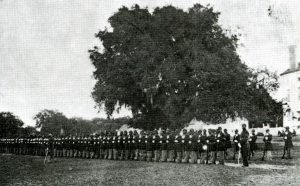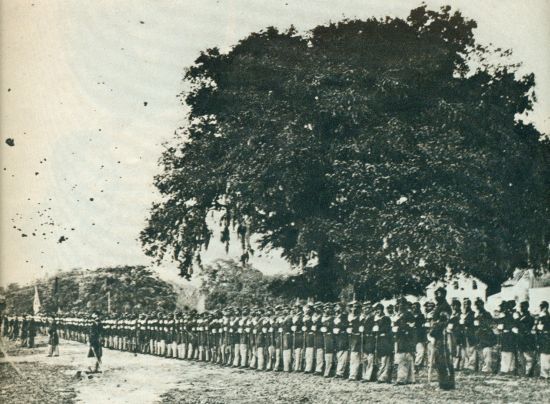The First South Carolina Volunteer Infantry was the first officially recognized black unit of the Union Army during the Civil War. It was quietly authorized by President Abraham Lincoln and organized in August of 1862. The regiment reached its full complement of 1,000 men and was mustered in during November of that year. The First South Carolina Volunteers were deployed almost two months before the Emancipation Proclamation was issued on January 1, 1863 (and before the 54th Massachusetts Infantry Regiment was organized). On January 1, they were issued regimental colors and “officially” accepted into the Union Army. In February 1864 they became officially the 33rd United States Colored Troops Regiment.
This was not the first attempt at a South Carolinian black regiment; Major General David Hunter, who took command of the Union Troops in the Department of the South in March of 1862, had raised a regiment of 500 black men, but without the necessary political support, he was forced to disband it in August. At the same time, Robert Smalls, an escaped slave and a Union War hero, traveled to Washington, D.C. to request permission for African American men to serve in the Union Army. Five days later, on August 25, 1862, and only two weeks after Hunter’s regiment was disbanded, Lincoln authorized the creation of a South Carolinian black regiment.
Early recruits were largely Gullah men from the South Carolinian and Georgian Sea Islands including 100 holdovers from Hunter’s regiment who formed the Volunteers’ A Company. Like other black regiments, however, all of the First South Carolina Volunteer Infantry’s officers were white, and its commander was Colonel Thomas Wentworth Higginson, a noted abolitionist. He was succeeded by Lt. Colonel Charles Trowbridge, who had been involved in recruitment and had initially been captain of A Company. Other notables involved with the regiment were Harriet Tubman, who had been a nurse for Hunter’s regiment and had stayed on, and Susie Baker King Taylor, then a 14-year-old runaway slave, who also became a nurse. She later married one of its soldiers, Edward King, and was the only black woman to publish a Civil War memoir.
While the regiment was never involved in any of the major battles of the war, it did see action. In November 1862, before Colonel Higginson had arrived, Captain Trowbridge led the 100 soldiers of A Company on an expedition along the South Carolinian and Georgian coasts, destroying Confederate Saltworks and freeing slaves. From January 23 until February 1, 1863, Higginson led the Volunteers up the St. Mary’s River from Beaufort, in an attempt to surprise a Confederate encampment. Unfortunately, on January 26, the regiment encountered Confederate cavalry at “The Battle of the Hundred Pines.” The First South Carolina Volunteers fought them off, taking only minimal casualties, but any chance of surprise was gone. The regiment helped claim Jacksonville, Florida for the Union on two separate occasions, once in March 1863 and again in February 1864. They were also involved in the Battle of Honey Hill and the capture of a fort on James Island both in South Carolina.
On February 9, 1866, the 33rd United States Colored Troops Regiment was mustered out at Fort Wagner, South Carolina.


